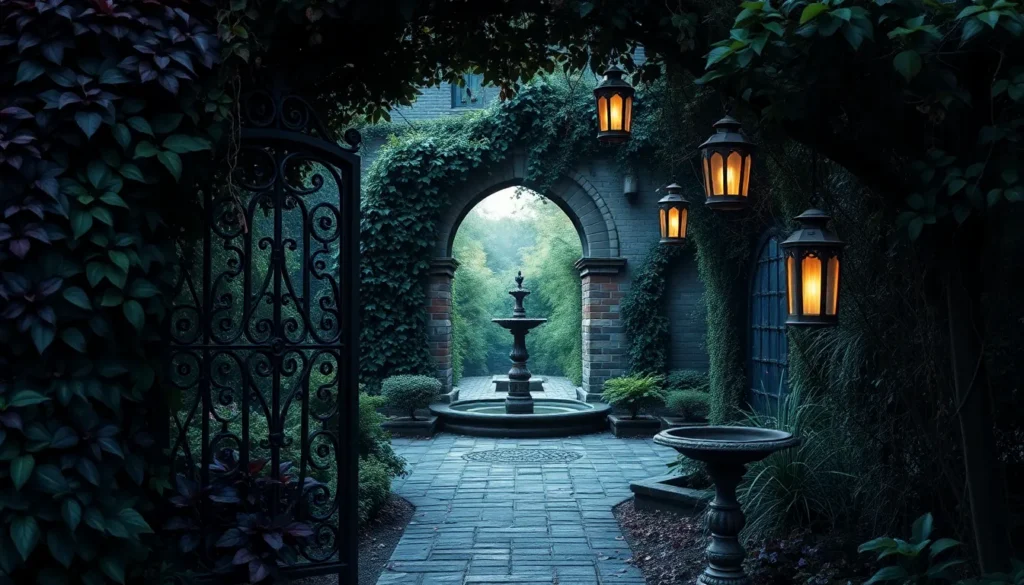We’ve all experienced the enchanting allure of mysterious gardens where shadows dance between dark foliage and moonlight illuminates weathered stone pathways. Gothic gardens offer a dramatic departure from traditional bright and cheerful landscapes creating spaces that feel both romantic and mysterious.
These captivating outdoor sanctuaries blend architectural elements like wrought iron gates ornate sculptures and aged stonework with carefully selected plants that thrive in darker conditions. We’re talking about deep purple blooms midnight-colored foliage and plants that seem to whisper secrets in the evening breeze.
Whether you’re drawn to the haunting beauty of Victorian-era design or simply want to create a unique outdoor space that reflects your darker aesthetic sensibilities gothic gardens provide endless possibilities for creative expression. From small corner transformations to complete backyard makeovers we’ll explore how to bring this timeless mysterious charm to your own outdoor space.
Create a Dark and Mysterious Entrance with Gothic Archways
Gothic archways serve as dramatic focal points that immediately establish your garden’s dark romantic character. These architectural elements create natural transitions between different garden spaces while adding vertical interest and shadowy depth.
Stone Archways with Climbing Vines
Stone archways provide the perfect foundation for creating haunting garden entrances that evoke medieval castle courtyards. We recommend using weathered limestone or aged brick to achieve that authentic gothic appearance that speaks to centuries of history.
Dark ivy varieties transform plain stone into living sculptures over time. English ivy creates dense coverage that clings naturally to rough stone surfaces, while Boston ivy offers dramatic seasonal color changes from deep green to blood red. Both species thrive in partial shade conditions typical of gothic garden settings.
Climbing roses with deep blooms add romantic mystery to your stone archways. Black Baccara roses produce velvety dark burgundy flowers that appear almost black in low light, while Mister Lincoln varieties offer classic deep red blooms with intoxicating fragrance. These climbing varieties can reach 8 to 12 feet in height, perfectly framing standard archway dimensions.
Clematis vines provide additional flowering options with their dramatic blooms and twisting growth patterns. Purple varieties like Jackmanii produce masses of deep violet flowers from summer through fall, while darker cultivars such as Niobe offer rich burgundy petals with contrasting yellow centers.
Wrought Iron Gates with Ornate Details
Wrought iron gates enhance stone archways with intricate metalwork that catches shadows and creates interesting light patterns throughout the day. We suggest incorporating traditional gothic motifs like pointed arches, trefoils, and quatrefoils into your gate design.
Antique or antiqued finishes give new ironwork the weathered appearance of centuries old installations. Rust patina treatments create authentic aging effects, while black oxide finishes provide classic gothic drama. Both options develop natural weathering over time that adds to their mysterious appeal.
Decorative hinges and hardware complete the authentic gothic look with period appropriate details. Heavy duty strap hinges with hammered textures support substantial gate weight while maintaining historical accuracy. Gothic style latches and lock mechanisms add functional beauty that complements the overall design aesthetic.
Height considerations impact both visual drama and practical functionality. Gates measuring 6 to 8 feet tall create impressive entrances without overwhelming smaller garden spaces, while 10 to 12 foot installations work better for grand estate settings or larger properties.
Gothic Style Pergolas
Gothic pergolas extend the archway concept into larger overhead structures that define pathways and seating areas within your dark garden sanctuary. These timber or metal frameworks support climbing plants while creating cathedral like spaces for contemplation.
Pointed arch construction distinguishes gothic pergolas from standard rectangular designs through their distinctive architectural profiles. We recommend using cedar or pressure treated lumber for wooden versions, as these materials withstand weather exposure while developing attractive gray patinas over time.
Multiple arch sequences create tunnel effects that draw visitors deeper into your gothic garden experience. Spacing arches 8 to 10 feet apart provides adequate walking clearance while maintaining structural integrity. This repetitive pattern mimics medieval cloister walkways found in ancient monasteries.
Plant selection for pergola coverage requires varieties that climb effectively while maintaining the dark aesthetic. Grape vines offer dense canopy coverage with dramatic autumn color changes, while wisteria provides cascading purple flower clusters that drip romantically from overhead beams. Both species create natural shade patterns that enhance the mysterious atmosphere below.
Design Shadowy Pathways Using Dark Materials
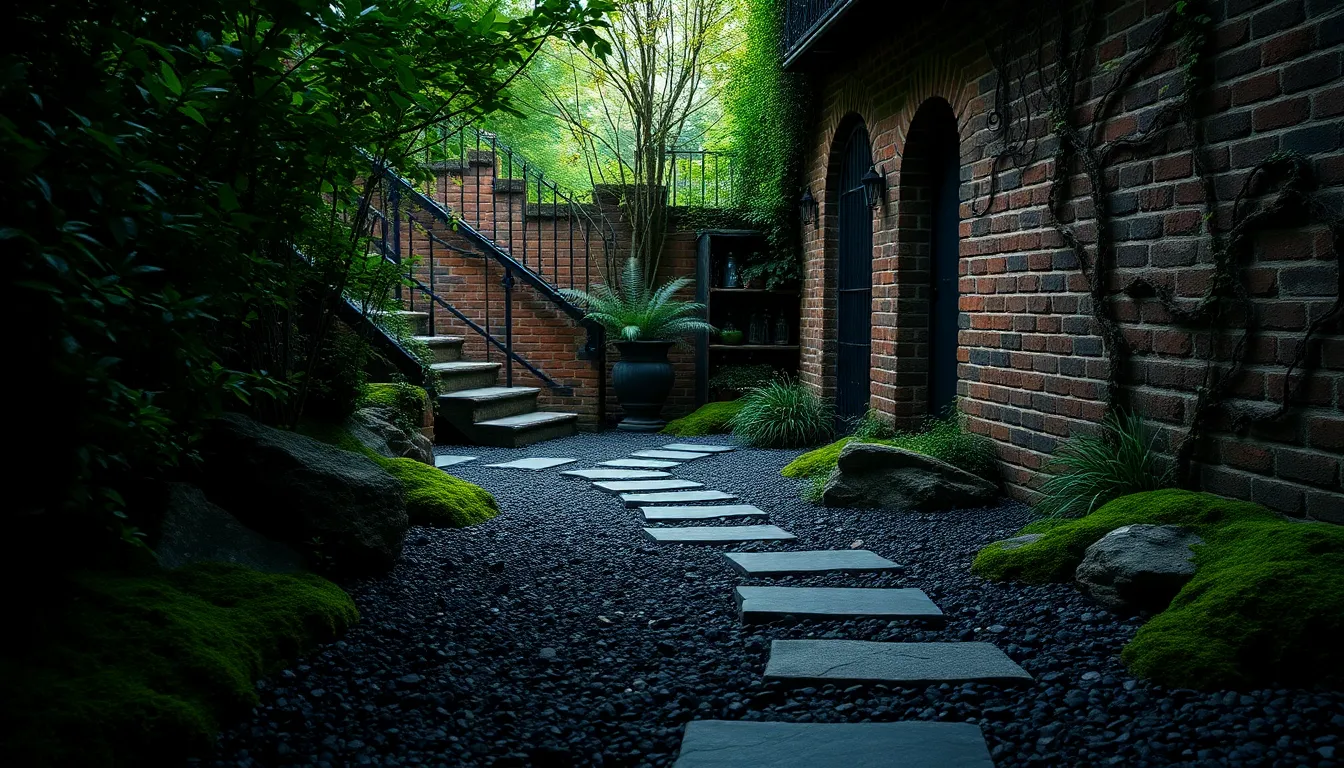
Creating mysterious walkways forms the backbone of any compelling gothic garden design. We’ll explore three distinctive approaches that transform ordinary paths into dramatic passages through your shadowy sanctuary.
Black Gravel and Slate Walkways
Black gravel pathways instantly absorb light and create striking contrast against surrounding vegetation. We recommend using angular black gravel or crushed slate to achieve the most dramatic effect, as these materials naturally complement gothic garden elements like wrought iron gates and weathered stonework.
Slate walkways offer another sophisticated option for gothic garden paths. These materials provide excellent texture while maintaining the dark, somber atmosphere that defines gothic design. We suggest combining black gravel borders with central slate stepping stones to create visual interest and guide visitors through your garden’s mysterious corners.
Installation becomes straightforward when we use proper base preparation and edging materials. Dark metal or aged stone edging helps contain the gravel while reinforcing the gothic aesthetic throughout your pathway design.
Moss-Covered Stone Stepping Stones
Moss covered stepping stones create an authentic aged appearance that suggests centuries of weathering. We achieve this natural look by selecting porous stones like limestone or sandstone that encourage moss growth over time.
Accelerating moss development requires a simple homemade mixture of yogurt and existing moss blended together. We paint this mixture directly onto stone surfaces and maintain moisture levels through regular misting, creating genuine mossy textures within weeks rather than years.
Placement strategies involve spacing stones irregularly to mimic natural wear patterns. We position larger stones at pathway curves and transition points, while smaller moss covered stones fill gaps and create organic flowing lines through shadowy garden areas.
Aged Brick Pathway Designs
Weathered brick pathways evoke old industry gothic gardens with their naturally distressed appearance. We source reclaimed bricks whenever possible, as their existing cracks and patina contribute authentic antiquated character to pathway designs.
Creating artificial aging becomes necessary when using new bricks in gothic garden applications. We apply diluted acid answers or use sandblasting techniques to develop weathered surfaces that complement gargoyles, stone arches, and other gothic architectural elements.
Installation patterns vary from traditional herringbone layouts to irregular cobblestone arrangements. We recommend combining aged bricks with dark mortar joints and allowing moss or small plants to establish between cracks, improving the mysterious woodland atmosphere that defines successful gothic garden pathways.
Incorporate Dramatic Architectural Elements
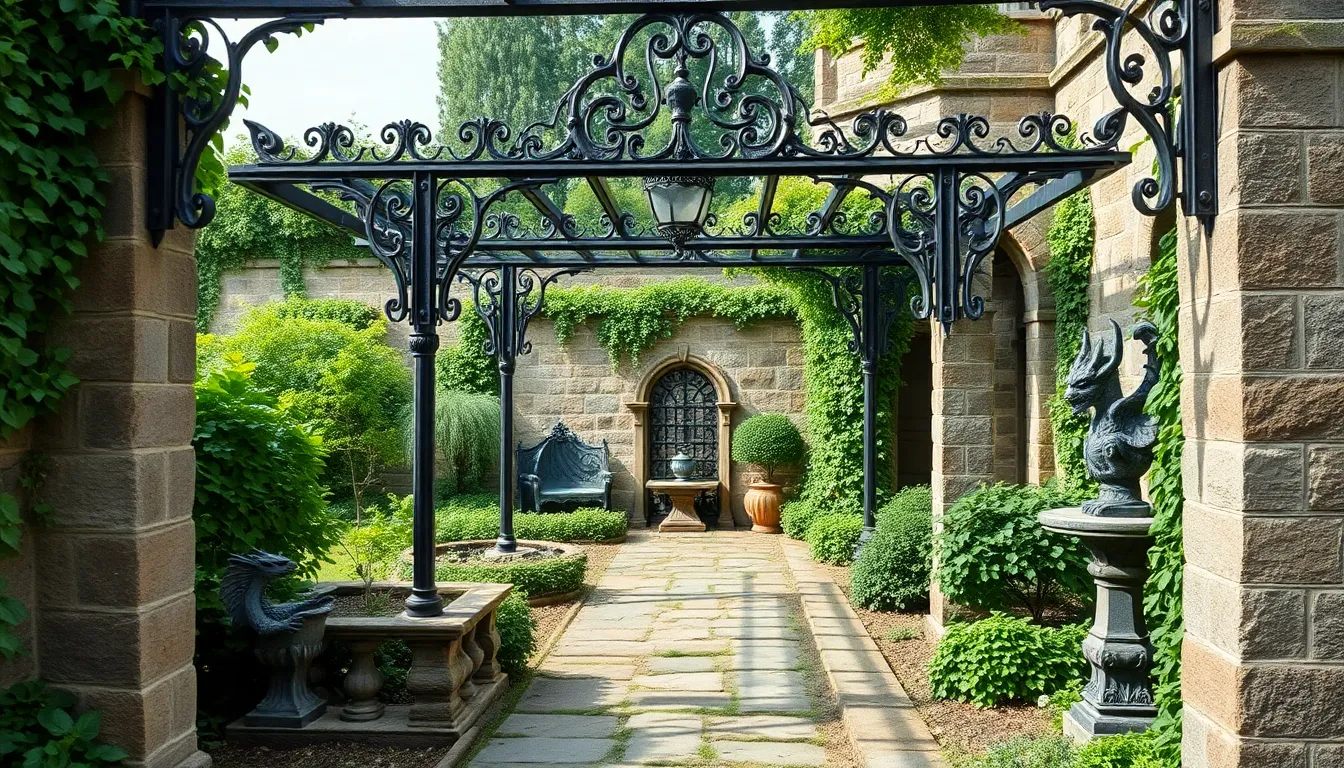
Gothic garden architecture transforms ordinary outdoor spaces into mysterious retreats that capture the essence of medieval grandeur. These structural elements serve as the backbone of your gothic design, creating dramatic focal points that evoke centuries of history.
Gothic Revival Garden Structures
Wrought iron pergolas define the quintessential gothic garden experience with their elegant metalwork and solemn presence. These 19th-century inspired structures feature intricate designs including finials, fleur-de-lis, and vine-like patterns that create an immediate sense of history and drama.
Cast-iron railings complement pergolas perfectly, offering both functionality and gothic aesthetic appeal. We recommend sourcing authentic pieces from second-hand shops or architectural salvage yards to ensure genuine character and weathered patina.
Elaborate scrollwork in both stone and iron adds sophisticated detail to garden borders and entrance ways. Position these elements strategically along pathways where visitors can appreciate the craftsmanship up close.
Tall, narrow windows incorporated into garden walls or standalone structures echo gothic cathedral architecture. These vertical elements draw the eye upward and create dramatic light patterns throughout your space.
Crumbling Stone Walls and Ruins
Weathered stone walls serve as the hallmark backdrop for authentic gothic gardens, suggesting age and mysterious abandonment. These structures provide essential vertical interest while creating intimate garden rooms and hidden corners.
Climbing ivy transforms new stonework into aged masterpieces when allowed to cascade over wall surfaces. Boston ivy and English ivy work particularly well for creating that centuries-old appearance we’re seeking.
Moss coverage accelerates the aging process on fresh stone surfaces through simple application techniques. Apply a yogurt and moss mixture directly to new stonework to encourage natural moss growth that makes walls appear genuinely ancient.
Artificial aging methods help new construction blend seamlessly with established gothic themes. Weather new stone using tea stains, moss applications, and strategic placement of climbing plants to achieve authentic aged effects.
Medieval-Inspired Garden Follies
Faux ruins create mysterious destinations at the end of meandering garden paths, inviting exploration and discovery. These miniature castles or tower structures can be constructed from reclaimed stone, weathered brick, or repurposed architectural materials.
Gargoyle statues positioned throughout folly structures reinforce the medieval atmosphere while serving as conversation pieces. Place these dramatic figures at entrances, corners, and elevated positions where they can “guard” your gothic sanctuary.
Dragon sculptures add whimsical intrigue when incorporated into folly designs or positioned as standalone features. These mythical creatures connect your garden to medieval folklore and fantasy literature.
Angel statues provide ethereal balance to more dramatic gothic elements, creating contemplative spaces within your garden. Position these serene figures in quiet corners or near water features where their peaceful presence can be fully appreciated.
Hidden chambers within larger folly structures create secret garden rooms perfect for meditation or intimate gatherings. Design these spaces with stone benches, dim lighting, and climbing plants that enhance the mysterious atmosphere.
Plant a Moody Color Palette of Dark Foliage
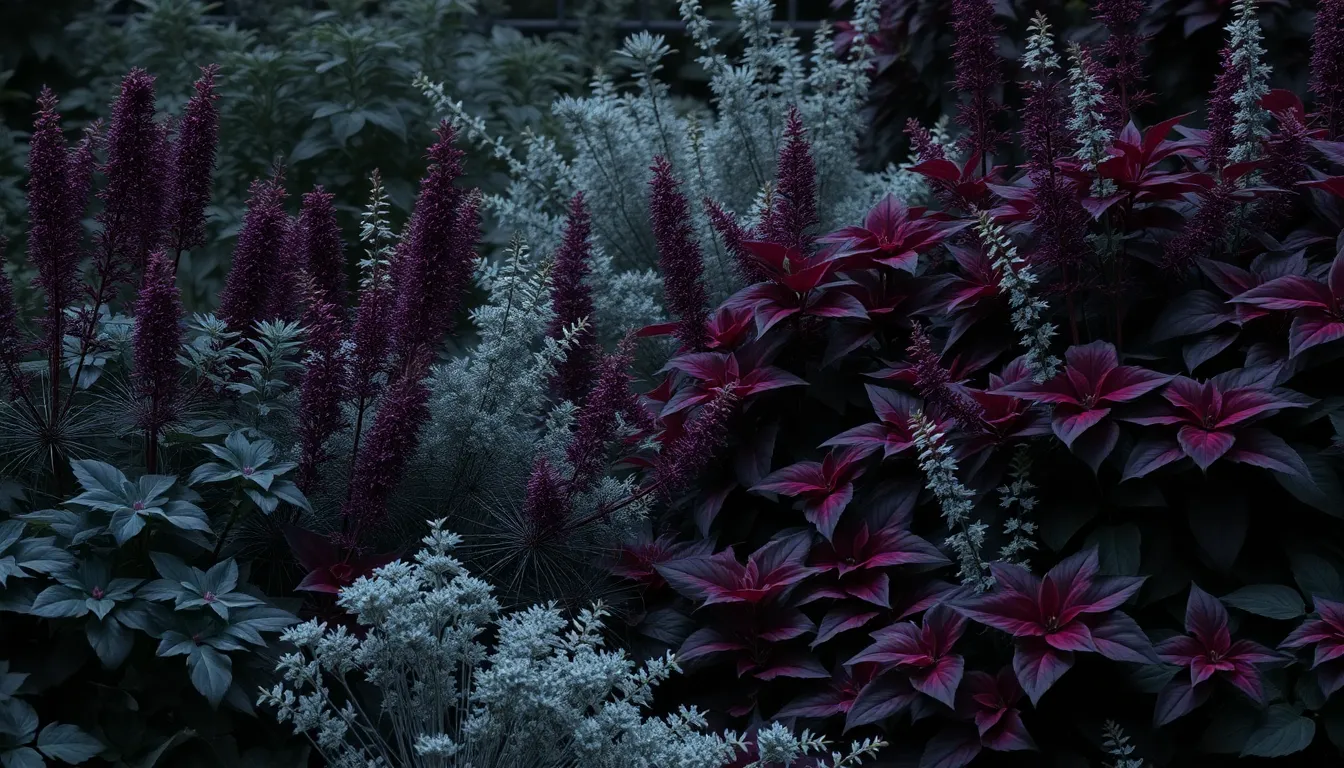
Building a gothic garden’s foundation relies on selecting plants that create visual drama through dark, moody colors. We’ll focus on three essential categories that work together to establish the mysterious atmosphere your gothic sanctuary demands.
Deep Purple and Burgundy Flowering Plants
Astilbe ‘Dark Side of the Moon’ transforms shaded areas with its deep chocolate brown leaves and rosy-purple flowers that bloom throughout summer. This perennial creates striking contrast between its dark foliage and vibrant blooms. Canna Tropicanna® Black delivers bold visual impact with bronze foliage that supports bright red blooms, making it perfect for gothic garden borders and containers.
Heuchera ‘Black Pearl’ offers year-round interest with jet-black leaves featuring rosy-purple undersides and delicate white flowers in spring. These coral bells thrive in partial shade and provide consistent dark color throughout growing seasons. Coleus ‘Black Prince’ brings nearly solid maroon-black foliage to your garden design, creating dramatic backdrops for lighter accent plants.
These purple and burgundy varieties establish the primary color story that defines gothic garden aesthetics. Plant them in groups of three to five for maximum visual impact and seasonal continuity.
Black and Dark Green Leafy Varieties
Black Mondo grass creates dense, purple-black grass-like foliage that works exceptionally well as groundcover or border edging. This low-maintenance perennial maintains its dark color throughout most seasons and tolerates various light conditions. Ninebark ‘Diabolo’ develops deep purple shrub leaves that provide substantial structure and height variation in your gothic industry design.
Elderberry ‘Black Lace’ combines lacy black foliage with pink flowers, offering both ornamental value and potential fruit harvest. This deciduous shrub grows 6 to 8 feet tall and creates excellent screening for gothic garden boundaries. Weigela ‘Dark Horse’ features dark bronze leaves with purplish-pink flowers that bloom in late spring and early summer.
Aeonium ‘Zwartkop’ adds exotic appeal with purple-black rosettes that form stunning architectural shapes. These tender succulents work well in containers that you can move indoors during winter months in colder climates.
Silver and Gray Accent Plants
Artemisia introduces silvery-gray foliage that creates ghostly contrast against dark purple and black plants in your gothic garden. This drought-tolerant perennial maintains its ethereal color throughout growing seasons and requires minimal maintenance. Dusty Miller provides soft, silvery leaves that enhance the mysterious atmosphere while adding textural variety to your plant combinations.
Lambs’ Ear contributes fuzzy, silver-gray leaves that create tactile interest and cooling visual breaks between darker foliage groups. These perennials spread naturally to form attractive groundcover patches that suppress weeds effectively. Silver accent plants amplify the gothic aesthetic by creating moonlit effects that make dark plants appear more dramatic and mysterious.
Position these light-colored varieties strategically throughout your gothic garden to prevent overwhelming darkness while maintaining the moody atmosphere you’re creating.
Add Mysterious Water Features
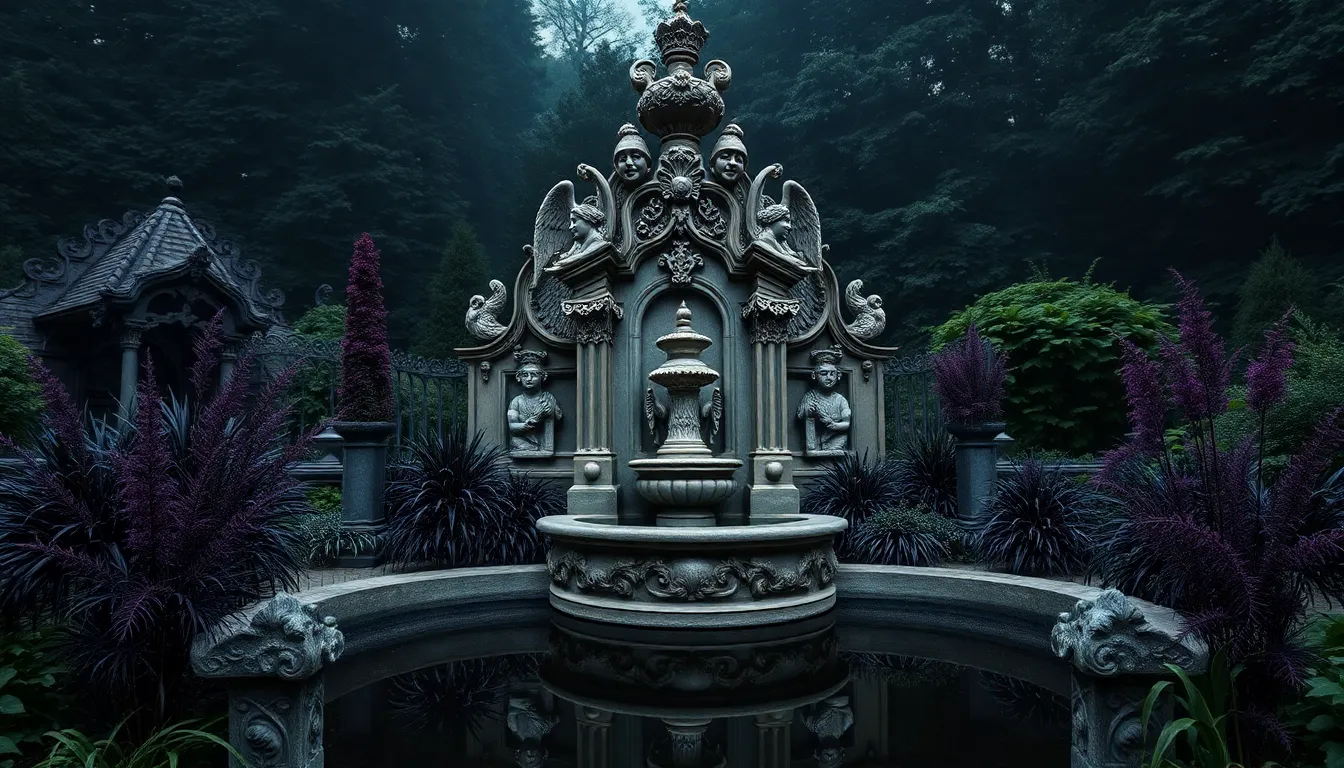
Water elements bring captivating drama to gothic gardens, creating focal points that enhance the mysterious atmosphere we’ve carefully cultivated.
Gothic Fountain Designs
Gothic fountain designs transform ordinary water features into stunning architectural statements that anchor your dark garden aesthetic. We recommend incorporating fountains with intricate stone carvings featuring medieval-inspired motifs like angels, cherubs, or gargoyles to establish a sense of history and mysticism. These detailed sculptures create dramatic focal points while the gentle sound of flowing water adds an ethereal quality to your space.
Ornate stonework elevates these fountains beyond simple water features, turning them into conversation pieces that reflect gothic architectural traditions. Medieval-style tiered fountains work particularly well when surrounded by our previously discussed dark foliage plants like Black Mondo grass and deep purple astilbe. Central placement allows these fountains to serve as commanding focal points, while corner installations create intimate gathering spaces perfect for contemplation.
Dark Reflecting Pools
Dark reflecting pools create mesmerizing mirror effects that double the visual impact of your gothic garden elements. We suggest using dark-colored stone or black tiles to construct pools that reflect surrounding industry features, creating an illusion of infinite depth and mystery. These pools work exceptionally well when positioned to reflect your gothic archways, pergolas, or architectural follies.
Strategic placement in secluded garden areas enhances their mystique, making them feel like hidden discoveries rather than obvious features. Surrounding these pools with our recommended dark foliage plants like Black Pearl heuchera and Elderberry ‘Black Lace’ creates seamless transitions between water and industry. The reflective surface captures moonlight beautifully, extending your garden’s dramatic appeal into evening hours.
Stone Gargoyle Water Spouts
Stone gargoyle water spouts add authentic medieval gothic architecture elements while serving functional drainage purposes. We position these carved figures as water spouts that appear to drain pools or fountains, creating theatrical water flow effects that enhance your garden’s dramatic atmosphere. Each gargoyle becomes a unique sculptural element that reinforces the gothic theme while managing water circulation.
Weathered stone finishes on these gargoyles create authentic aged appearances that complement our weathered brick pathways and moss-covered stepping stones. Multiple gargoyles positioned at different heights create cascading water effects, while single statement pieces work well as primary focal points. These functional sculptures pair beautifully with climbing vines like English ivy, which can partially cover them to suggest centuries of natural growth.
Install Atmospheric Gothic Lighting
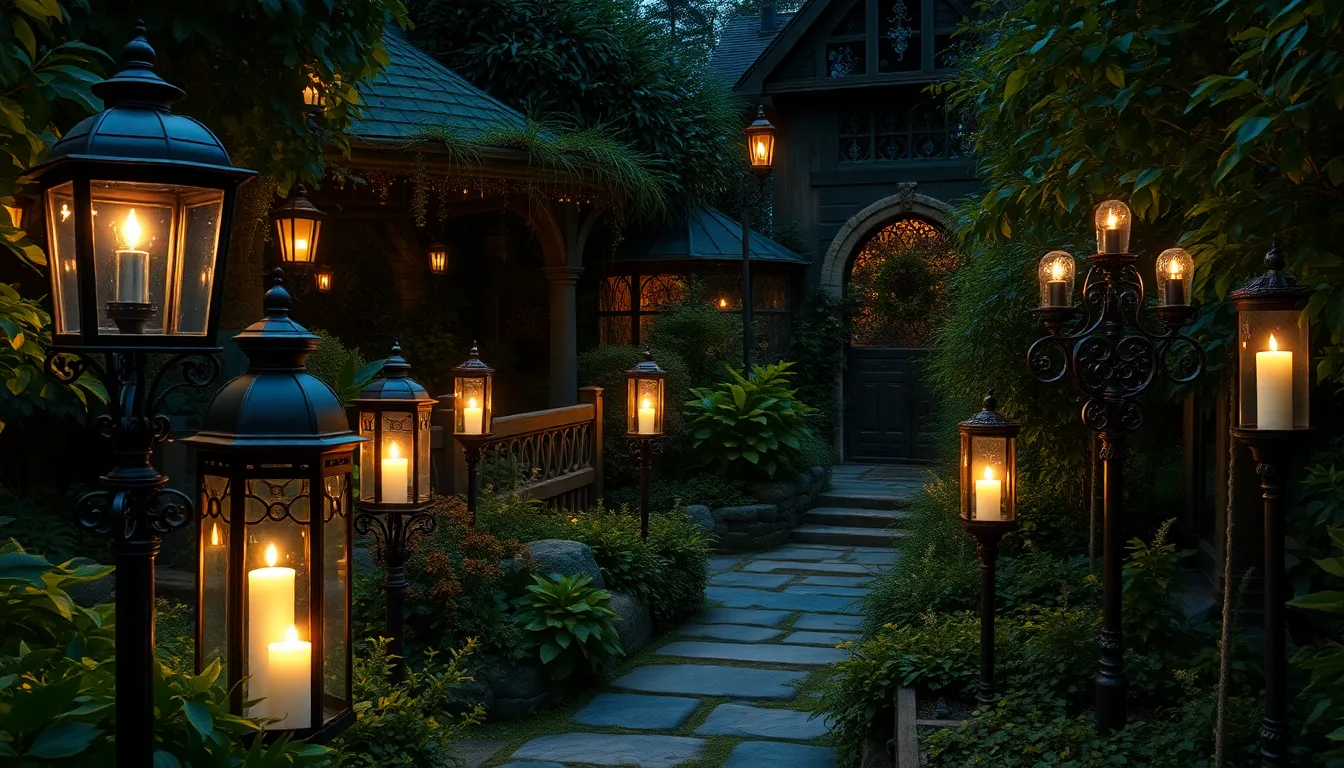
We’ll transform your garden’s ambiance through carefully selected lighting elements that enhance the mysterious and enchanting gothic atmosphere.
Lantern-Style Garden Lights
Lantern-style garden lights create the perfect moody ambiance for your gothic sanctuary. We recommend hanging these fixtures from tree branches or pergola structures to cast dramatic shadows throughout your space. Victorian and medieval design lanterns work exceptionally well, featuring ornate metalwork and aged finishes that complement your gothic theme.
Position multiple lanterns at varying heights to create depth and visual interest. Cast-iron lanterns with glass panels provide durability while maintaining authentic period styling. We suggest spacing these fixtures 8-10 feet apart along pathways to ensure adequate illumination without overwhelming the mysterious atmosphere.
Candle-Lit Garden Arrangements
Candle-lit arrangements add a spooky yet beautiful glow that perfectly captures the gothic essence. We place candles strategically throughout the garden using glass holders or metal lanterns to protect flames from wind while improving the overall ambiance. Hurricane glass protectors work particularly well for maintaining consistent lighting during evening gatherings.
Create groupings of three to five candles at different heights near seating areas or architectural features. Wrought iron candelabras make excellent focal points when positioned near gothic statuary or reflecting pools. We recommend using LED candles for safety in areas with overhanging vegetation or during unattended periods.
Solar Gothic Lamp Posts
Solar gothic lamp posts provide sustainable lighting while maintaining your garden’s authentic aesthetic appeal. These fixtures often feature Victorian-style designs with ornate detailing that adds mystique to your outdoor space. We choose models with warm LED bulbs that emit a soft, atmospheric glow rather than harsh white light.
Install these posts along main pathways and at garden entrances to guide visitors through your gothic industry. Quality solar posts charge efficiently during daylight hours and provide 6-8 hours of evening illumination. We position them 12-15 feet apart to create consistent lighting coverage while preserving the garden’s shadowy character between illuminated areas.
Create Spooky Garden Sculptures and Statuary
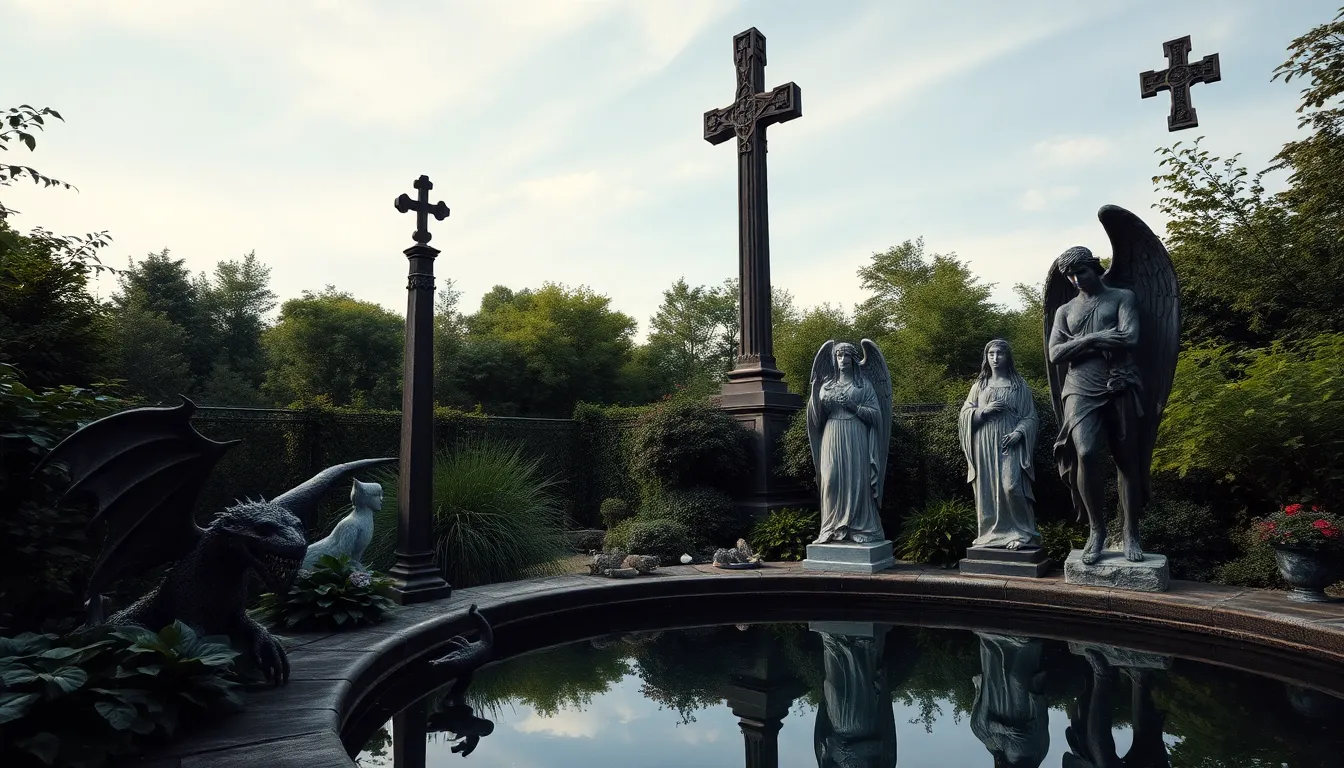
Sculptures and statuary form the dramatic heart of any gothic garden, transforming ordinary outdoor spaces into mysterious landscapes that captivate and intrigue visitors. We’ll explore three essential categories of gothic garden sculptures that create the perfect atmospheric foundation.
Gargoyle and Dragon Figurines
Gargoyles and dragon figurines bring medieval mythology directly into our garden spaces, evoking ancient cathedral exteriors and fantasy realms. We recommend positioning these sculptural elements on gate posts, garden walls, or nestled within dark foliage beds to create surprising encounters for visitors. Stone and resin materials work exceptionally well for these pieces, offering durability while maintaining the authentic weathered appearance that defines gothic aesthetics.
Dragon figurines add an element of fantasy adventure to secluded garden corners, while gargoyles traditionally serve as protective guardians that ward off negative energy. We suggest mounting wall gargoyles at eye level or slightly above to maximize their dramatic impact, particularly when flanking garden entrances or framing doorways. Clustering smaller dragon figurines among hostas or ferns creates delightful discovery moments that enhance the garden’s sense of mystery and enchantment.
Gothic Angel and Saint Statues
Gothic angel and saint statues introduce ethereal beauty and historical reverence that connects our gardens to centuries of religious art and cathedral design. We find these sculptural elements work beautifully near reflecting pools or water features, where their serene expressions create contemplative focal points. Cast iron and carved stone versions offer the most authentic appearance, particularly when weathered patina develops naturally over time.
Positioning angel statues requires careful consideration of sight lines and garden flow, with solitary placement often proving more impactful than grouping multiple figures together. We recommend selecting pieces that range from 18 to 36 inches in height to create appropriate scale relationships with surrounding plantings. Saint statues work exceptionally well in garden alcoves or beneath arbors, where filtered light enhances their spiritual presence and creates natural shrine like settings.
Weathered Stone Crosses and Obelisks
Weathered stone crosses and obelisks provide vertical architectural elements that anchor gothic garden compositions while adding symbolic depth and historical gravitas. We use these monuments as pathway markers, garden room dividers, or solitary focal points that draw the eye upward and create dramatic silhouettes against dark foliage. Natural stone patina and moss growth enhance authenticity, though we can accelerate aging processes using yogurt and moss mixtures applied to newer pieces.
Obelisks work particularly well as centerpieces for formal garden beds or as terminals for long sight lines that create depth and perspective. We position stone crosses to frame garden entrances or mark transitions between different themed areas, taking advantage of their strong symbolic presence. Height variations among these monuments create rhythmic compositions, with pieces ranging from 3 to 6 feet tall providing optimal visual impact without overwhelming nearby plantings or structures.
Design Enclosed Gothic Garden Rooms
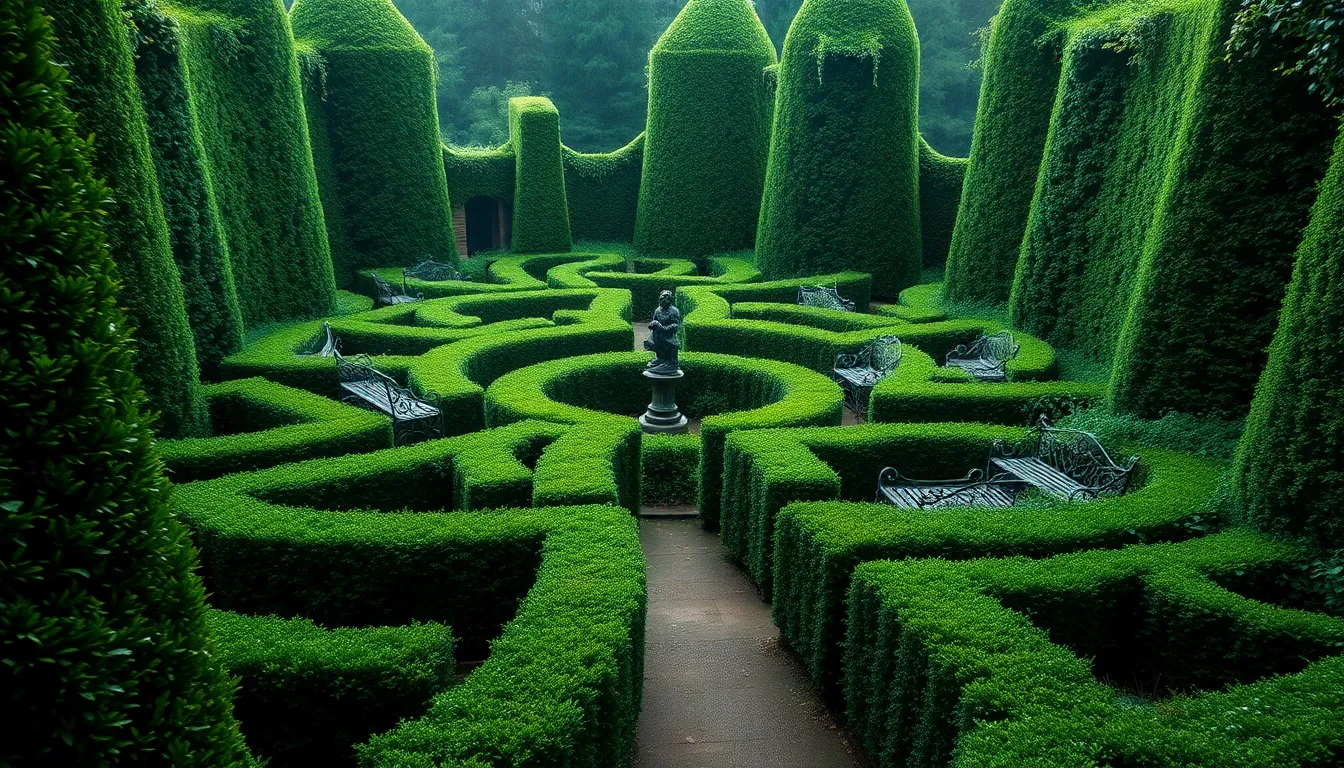
Creating intimate, enclosed spaces adds mystery and drama to your gothic garden design. We’ll explore three distinctive approaches that transform open landscapes into captivating secret chambers.
Hedge Maze Sections
Dense hedge walls create mysterious pathways that invite exploration and discovery. We recommend using yew, box, or privet hedges to form towering barriers that reach 6-8 feet in height. These traditional maze plants provide year-round structure and can be trimmed into precise geometric shapes.
Strategic maze design begins with planning dead ends and hidden alcoves throughout the winding paths. Each section should lead visitors deeper into the garden’s mysterious atmosphere. We suggest incorporating weathered stone benches or cast-iron statues at maze intersections to create moments of contemplation.
Maintenance considerations include regular pruning to maintain dense walls and clear pathways. Yew hedges require trimming twice yearly, while box hedges need monthly attention during growing season. We’ve found that mature hedge mazes take 3-5 years to establish their full gothic presence.
Walled Garden Courtyards
Stone and brick walls establish formal boundaries that create intimate garden rooms. We prefer using aged limestone or weathered brick to achieve an authentic medieval appearance. These materials develop natural patina over time, improving the gothic atmosphere.
Courtyard elements should include ornate wrought-iron gates with intricate scrollwork and antique bronze finishes. We recommend installing geometric planting beds filled with dark purple and burgundy flowering plants. Cast-iron fountains or weathered stone urns serve as dramatic centerpieces.
Wall height considerations typically range from 4-6 feet to maintain intimacy without blocking essential sunlight. Creeping vines like English ivy or climbing roses soften harsh stonework while adding vertical interest. We’ve observed that partially covered walls create more mystery than completely hidden barriers.
Secret Garden Alcoves
Hidden alcoves tucked behind stone walls or dense plantings offer secluded retreat spaces. We design these intimate corners using ornate cast-iron arches or weathered stone pergolas as entryway frames. Each alcove should feel like a discovered treasure within the garden’s layout.
Alcove features include cherub statues, gargoyle figurines, or weathered stone crosses positioned to create focal points. We recommend adding wrought-iron benches surrounded by dark foliage plants like Black Mondo grass or Heuchera ‘Black Pearl’. Moss covered stepping stones lead visitors into these secret spaces.
Lighting strategies use lantern-style fixtures or candle arrangements to enhance the mysterious ambiance during evening hours. Solar gothic lamp posts positioned along approach paths guide visitors while maintaining the space’s secluded character. We’ve found that subtle lighting creates more intrigue than bright illumination.
Establish a Gothic Herb and Apothecary Garden

Transform your gothic garden into a mysterious sanctuary by cultivating plants steeped in ancient lore and medicinal tradition. We’ll explore how to create an atmospheric herb garden that combines historical significance with dramatic visual appeal.
Medieval Medicinal Plants
Henbane serves as one of the most compelling additions to your gothic apothecary garden, known throughout history for its powerful sedative effects and mystical associations. We recommend planting this fascinating specimen in shadowy corners where its bell-shaped flowers can create an air of ancient mystery.
Valerian brings both historical authenticity and practical beauty to your gothic herb collection, valued for centuries for its remarkable calming properties. Position these fragrant plants near seating areas where visitors can appreciate their delicate white or pink blooms while contemplating their medieval significance.
Black sage offers dramatic dark foliage that perfectly complements the gothic aesthetic while maintaining its traditional ceremonial importance. We suggest grouping these plants together to create bold visual statements that enhance your garden’s mysterious atmosphere.
Dark-leaved coleus provides immediate visual impact with its rich burgundy and purple foliage, making it an excellent choice for creating depth in your medicinal plant borders. These versatile plants thrive in partial shade conditions typical of gothic garden settings.
Poisonous and Mysterious Plant Varieties
Deadly nightshade represents the ultimate gothic garden plant, combining dangerous beauty with centuries of folklore and mystery. We advise extreme caution when incorporating this plant, ensuring it’s placed away from children and pets while using it as a conversation piece about botanical history.
Hemlock adds historical intrigue to your garden collection, famous for its role in ancient philosophy and literature. Plant these specimens in secure areas where their delicate white flowers can be admired safely while respecting their toxic nature.
Datura brings both visual drama and mystical significance to your gothic herb garden, known for its large trumpet-shaped flowers and hallucinogenic properties. We recommend positioning these striking plants as focal points where their otherworldly appearance can capture visitors’ attention.
Mandrake offers legendary mystique to your collection, steeped in folklore about its supposed magical properties and human-like root system. These rare plants require special growing conditions but reward gothic gardeners with unmatched historical authenticity.
Antique Herb Labels and Markers
Distressed wood markers create authentic medieval atmosphere while helping identify your mysterious plant collection. We create these labels using weathered cedar or reclaimed barn wood, allowing natural aging to enhance their gothic appeal.
Metal plant tags fashioned from aged copper or wrought iron provide durable identification while maintaining period-appropriate aesthetics. Engrave these markers with calligraphy fonts or medieval-inspired lettering to enhance their historical authenticity.
Stone markers carved with plant names offer permanent, weather-resistant identification that complements gothic garden hardscaping. We recommend using slate or limestone for these custom labels, incorporating gothic script or Latin names for added mystery.
Apothecary-style labels made from parchment or aged paper housed in weatherproof frames bring authentic herbalist character to your garden displays. These detailed labels can include historical uses, folklore, and warnings about toxic plants, educating visitors while maintaining the gothic atmosphere.
Conclusion
Creating your own gothic garden sanctuary is an exciting journey that transforms ordinary outdoor spaces into extraordinary realms of mystery and beauty. We’ve explored the essential elements that make these gardens so captivating – from dramatic archways and shadowy pathways to haunting sculptures and atmospheric lighting.
The key to success lies in layering these elements thoughtfully. Start with one or two focal points like a gothic fountain or weathered stone pathway then gradually build your dark paradise with carefully chosen plants and architectural features.
Remember that gothic gardens aren’t just about aesthetics – they’re about creating an emotional experience. Whether you’re drawn to the romantic allure of climbing roses on wrought iron or the mystical appeal of herb gardens steeped in ancient lore your gothic garden will become a personal retreat that reflects your unique style and imagination.
Frequently Asked Questions
What is a gothic garden and how does it differ from traditional gardens?
A gothic garden creates a dramatic, mysterious atmosphere using dark colors, architectural elements, and shadowy spaces. Unlike traditional bright gardens, gothic gardens feature deep purple blooms, dark foliage, weathered stone structures, and wrought iron details. They emphasize Victorian-era design elements and create romantic, haunting landscapes that appeal to those seeking a darker aesthetic in their outdoor spaces.
What are the essential architectural elements for a gothic garden?
Key architectural features include gothic archways made of stone or metal, wrought iron gates with intricate designs, gothic-style pergolas with pointed arches, and weathered stone walls. Medieval-inspired garden follies like miniature castles, gargoyle statues, and cast-iron railings add historical drama. These elements create focal points and define spaces while establishing the garden’s mysterious character.
Which plants work best in a gothic garden design?
Gothic gardens thrive with deep purple and burgundy flowering plants like Astilbe ‘Dark Side of the Moon’ and Canna Tropicanna® Black. Black and dark green foliage plants such as Black Mondo grass and Heuchera ‘Black Pearl’ provide structure. Silver accent plants like Artemisia and Dusty Miller create contrast. Choose plants that perform well in shadowy conditions and complement the dark aesthetic.
How do I create effective pathways in a gothic garden?
Create shadowy pathways using three approaches: black gravel and slate walkways for dramatic contrast, moss-covered stone stepping stones for natural texture, or weathered brick pathways for vintage appeal. Use dark materials and allow natural weathering to enhance the mysterious atmosphere. Consider irregular patterns and varying textures to create visual interest and guide visitors through your gothic landscape.
What types of water features enhance a gothic garden?
Gothic fountains with medieval stone carvings serve as stunning focal points while adding ethereal water sounds. Dark reflecting pools create mesmerizing mirror effects and illusions of depth, especially when surrounded by dark foliage. Stone gargoyle water spouts combine functionality with artistic appeal, reinforcing the gothic theme while managing water circulation throughout your garden design.
How should I light a gothic garden for maximum atmosphere?
Use lantern-style garden lights hung from tree branches or pergolas for authentic ambiance. Group candles near seating areas to create spooky, flickering glows. Solar gothic lamp posts with Victorian-style designs provide sustainable pathway lighting. Focus on creating pools of light and shadow rather than bright illumination to maintain the mysterious, romantic atmosphere essential to gothic garden design.
What sculptures and statuary work best in gothic gardens?
Essential sculptures include gargoyle and dragon figurines that evoke medieval mythology, gothic angel and saint statues for ethereal beauty, and weathered stone crosses or obelisks for vertical architectural interest. Place larger pieces as focal points and smaller statues throughout plantings. Choose materials like aged stone, cast iron, or weather-resistant resin to withstand outdoor conditions while maintaining authentic appearance.
How do I create enclosed spaces within my gothic garden?
Design garden rooms using hedge maze sections with dense yew or box hedges, walled garden courtyards with stone or brick barriers, and secret garden alcoves featuring ornate arches. These enclosed spaces create intimate areas for contemplation and discovery. Include focal points like statues or fountains within each room, and use strategic lighting to create inviting atmospheres within these mysterious spaces.

